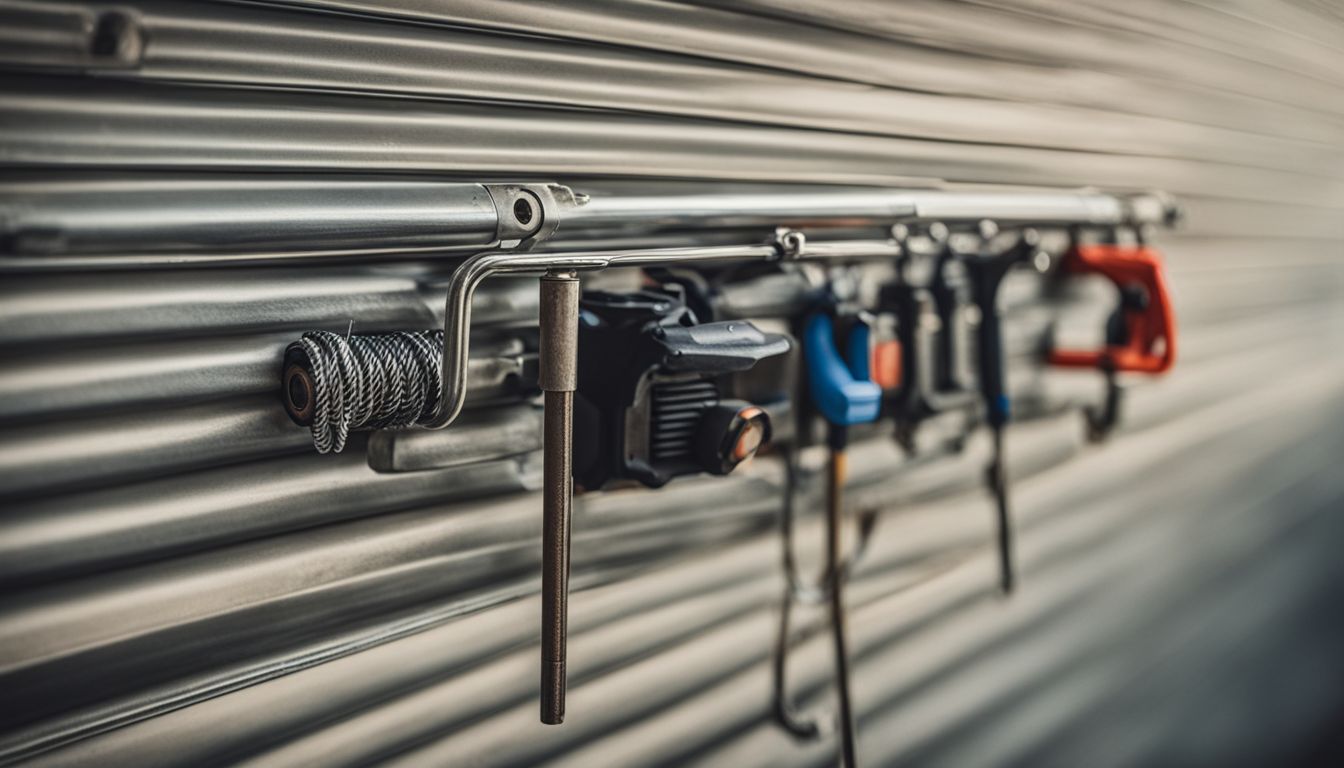If your garage door refuses to open smoothly, you might be dealing with a broken spring. Garage door springs are crucial for balancing and lifting the hefty door, ensuring safe operation.
Our blog offers practical advice and essential steps to address this common but challenging issue effectively. Keep reading for stress-free solutions!
Key Takeaways
- Garage door springs, essential for lifting and balancing the weight of the door, come in various types including torsion and extension springs.
- Broken garage door springs can be identified by a loud bang, difficulty opening the door, or visible gaps in the spring coil.
- Attempting DIY repairs on garage door springs is dangerous; professional technicians should be contacted for safe and effective repair.
- Regular maintenance such as inspections and lubrication can prolong the lifespan of garage door springs.
- Both torsion and extension springs should ideally be replaced together to maintain balance and functionality of your garage system.
What are Garage Door Springs

Garage door springs are essential components that help in the smooth operation of your garage door. There are two main types of garage door springs – extension and torsion springs, each serving a specific purpose to support the weight of the door.
Understanding their function is crucial in recognising when there is an issue with them.
Types of Garage Door Springs
- Extension Springs: These are mounted along the tracks on either side of the garage door. When the door closes, extension springs stretch and store energy. During opening, this energy helps to lift the garage door. Proper adjustment ensures they function safely.
- Torsion Springs: Located above the garage door opening, torsion springs wind and unwind to create torque that moves the door. A spring bar/torsion tube holds them in place with drums at each end to maintain balance.
- EZ-Set Spring System: This is a variation designed for easier installation and adjustment by homeowners, minimising the hassle of traditional systems.
- Torquemaster Spring System: Offering a contained option, these springs inside a tube provide safety by preventing loose parts if a spring breaks occurs.
The Role of Springs in Garage Door Functionality
Springs are crucial for the effortless opening and closing of garage doors, providing the necessary lifting force to move the hefty door. Torsion springs and extension springs each play a distinct role in this process.
With torsion springs positioned above the door opening, they utilise a spring bar or torsion tube to help balance and manage the weight as it moves. On the sides of a garage door, you’ll find extension springs which require precise installation and adjustment to ensure safe operation.
Maintaining proper spring tension is vital for smooth functionality. If these components fail or wear out, your garage door may become unbalanced and potentially hazardous to operate.
Since attempting repair work on these high-tension parts can be dangerous, it’s often best left to an experienced garage door technician with suitable tools and know-how. Properly functioning springs enable manual mode use during power outages or when disconnecting from garage door openers; they’re essential cogs in your home’s largest moving machinery system.
Recognizing a Broken Garage Door Spring

When a garage door spring breaks, it can be easily spotted through visual indicators such as a noticeable gap in the spring or a loud snapping sound. The risks of operating a door with a broken spring are high, so it’s important to recognise these signs and take immediate action.
Why do garage door springs break
Garage door springs handle immense forces every time the door opens or closes. Over time, this constant tension can lead to wear and tear, ultimately causing the springs to snap. Metal fatigue plays a significant role as the material of the spring gradually weakens under repeated stress cycles.
Regular use isn’t the only culprit; poor maintenance also contributes significantly to spring failure. Neglecting regular inspections means minor issues go unnoticed and can escalate into major problems.
Cold weather puts additional strain on garage door springs. Low temperatures cause metal to contract, making it less flexible and more prone to breaking under pressure. Proper safety precautions are a must when dealing with worn or broken springs—attempting a do-it-yourself repair without the correct tools, like winding bars, or protective gear, such as eye protection, invites risk of injury.
It’s essential for homeowners to leave spring replacement tasks to professionals who have both experience and equipment necessary for safe and effective repairs.
Visual Indicators of a Broken Spring
Knowing how to spot a broken garage door spring can save you from potential danger and unexpected repair costs. Visual signs are often the first indication that something is wrong with your garage door springs.
- Gap in the Spring: Torsion springs should maintain a tight, coiled shape. If you see a noticeable gap, it implies the spring has snapped.
- Door Won’t Open Completely: A broken extension spring may prevent your garage door from opening fully, as these are critical for providing lifting power.
- Unusual Sounds: A loud bang coming from the garage often signals that a torsion spring has broken due to the unwinding force.
- Bent Top Section of the Door: When trying to open with a broken spring, your garage door may bend at the top because it cannot properly balance its weight.
- Jerky Motion: If you notice an uneven or jerky motion as the door opens or closes, this could mean one of the extension springs is damaged and not functioning correctly.
- Cable Issues: Cables may become loose or appear to dangle if their tension is released suddenly due to a spring breakage.
- Difficulty Using Manual Mode: Should your automatic opener fail to work, switching to manual mode will be tough if springs are broken since they assist in lifting.
Risks of Operating a Door with a Broken Spring
Operating a garage door with a broken spring is dangerous and could lead to severe injury. Without the support of a functioning spring, the heavy door becomes unpredictable and may close rapidly without warning.
This risk increases if you attempt to open or close the door manually or use the opener. The sudden release of tension can send metal components flying, posing an immediate threat to anyone nearby.
You must take safety seriously when dealing with damaged springs, ensuring that eye protection and leather gloves are worn at all times while handling tools such as winding bars. Disconnecting the garage door opener is crucial to prevent accidental activation during repair attempts.
It’s particularly important not to try moving vehicles out of the garage unless professionals have secured the door; this action requires expertise due to the weight and potential instability of an impaired garage system.
Immediate Steps to Take When a Spring Breaks

When a garage door spring breaks, it’s important to prioritise safety by avoiding DIY repairs and contacting professional services immediately. Taking immediate action can prevent further damage and ensure the safety of everyone around the garage door.
Safety Precautions
Safety precautions are crucial when dealing with a broken garage door spring. They ensure your protection while preventing further damage to the garage door system.
- Always use the right tools, like proper winding bars, which fit securely into the winding cone holes of torsion springs. This prevents slippage and potential injury.
- Wear eye protection to shield your eyes from potential flying debris or spring parts during repair.
- Put on heavy – duty leather gloves to protect your hands from sharp edges and the tension of the springs.
- Disconnect the garage door opener to prevent accidental activation while you work on the springs.
- Secure the door in its closed position by clamping locking pliers onto the track just above one of the rollers. This stops it from suddenly rolling up and causing harm.
- Keep children and pets away from the garage during repairs to avoid distractions and accidents.
- Examine all bolts and screws during maintenance checks to ensure they are tight and secure. Loose hardware can lead to accidents.
- Seek assistance from professionals if you lack experience with garage door repairs. Trying ‘doing it yourself’ without proper knowledge poses serious risks.
Contacting Professional Services
If your garage door spring snaps, immediate action is crucial. Tim Sweeney’s expertise in residential and commercial garage door installations and repairs ensures a reliable solution to your problem.
Avoid the temptation of fixing it yourself – this is a job for seasoned professionals who have the necessary tools and know-how.
For urgent situations, don’t hesitate to call for emergency services or gather multiple estimates over the phone. Once you’ve secured professional help, they’ll handle all aspects of the repair safely and efficiently, freeing you up from potential harm or further damage to your garage door system.
Next up: How can we make these springs last longer? Let’s find out.
How Can You Make Garage Door Springs Last Longer?

Regular maintenance and inspections are key to ensuring the longevity of your garage door springs. Understanding how long torsion and extension springs last can help you plan for their eventual replacement.
How long do torsion springs last
Torsion springs play a critical role in the smooth operation of your garage door. Typically, these vital components can last anywhere between 7,000 to 10,000 cycles of opening and closing the door.
To put this into perspective for an average user, if you use your garage door about twice a day, your torsion springs might hold up for nearly a decade.
For those seeking longer service life from their garage door springs, manufacturers offer double-life torsion springs that endure up to 25,000 cycles. Regularly oiling and maintaining these springs will significantly enhance their durability.
This attention helps not only in prolonging spring life but also benefits other elements of the system ensuring consistent performance over time.
Do extension springs wear out
Extension springs can wear out over time due to the constant tension and cycles of stretching and contracting as the garage door is opened and closed. Without regular maintenance, such as lubrication and inspections for wear or damage, extension springs are more likely to weaken and eventually break.
It’s essential to be proactive in caring for extension springs to maximise their lifespan and prevent sudden failure, which can lead to significant damage or injury.
Regularly inspecting extension springs for signs of wear, such as gaps or stretched coils, along with maintaining a consistent lubrication schedule can help prolong their functional life.
The Repair Process for Broken Garage Door Springs
When garage door springs break, it is essential to understand the repair process. This section will cover what happens when garage door springs break, the difference between replacing torsion springs and extension springs, and why it’s important to replace both springs.
What Happens When Garage Door Springs Break?
Garage door springs are under extreme tension and when they break, they can produce a loud noise akin to a gunshot. The sudden release of tension causes the door to drop rapidly. This poses a serious safety risk to anyone nearby.
In addition, attempting to open or close the door with a broken spring can put strain on the garage door opener, potentially leading to damage.
Replacement of garage door springs is not a DIY task due to the specialised tools and knowledge required. Calling professional services is essential for safe and proper repair. Opting for prompt professional assistance minimises the risk of injury and ensures that your garage door functions properly again without compromising safety.
Replacing Torsion Springs vs Extension Springs
Torsion springs and extension springs are two common types of garage door spring systems. When it comes to replacing these springs, there are key differences to consider:
- Weight Distribution: Torsion springs distribute the weight of the garage door more evenly, providing smoother operation and reducing wear and tear on the door and opener.
- Lifespan: Torsion springs generally have a longer lifespan than extension springs, making them a durable and reliable option for long-term use.
- Safety: Torsion springs are considered safer than extension springs as they are mounted above the garage door, minimising the risk of accidents or injuries.
- Upgrade Potential: Homeowners with an extension spring system can opt to upgrade to a torsion spring system for improved safety and longevity.
- Professional Guidance: Consulting a garage door technician can provide valuable insights into which type of spring system is best suited for your specific garage door and usage requirements.
The Importance of Replacing Both Springs
Replacing both springs is crucial for maintaining the proper balance and functionality of the garage door. By replacing both springs simultaneously, the wear and tear on each spring are evenly distributed, ensuring a more balanced operation.
This also helps to prevent future issues with one spring wearing out before the other. Additionally, by replacing both springs at once, it ensures that they have equal tension and remain in sync, preventing potential strain on the garage door system.
It is important to note that when only one spring is replaced while leaving the other intact, it may lead to uneven stress distribution and potentially impact the smooth functioning of your garage door over time.
Preventative Measures and Maintenance Tips
Regular inspections and maintenance are crucial for preventing garage door spring issues, so be sure to read on for more tips on how to keep your garage door springs in top condition.
Regular Inspections and Maintenance
Regular inspections and maintenance of garage door springs are crucial for ensuring the smooth functioning and longevity of your garage door system. By following these essential tips, you can prevent unexpected breakage and potential safety hazards:
- Conduct visual inspections at least every three months to check for signs of wear, rust, or damage on the springs, cables, and hardware.
- Perform regular lubrication of the garage door spring, rollers, and hinges using a high-quality silicone-based lubricant to reduce friction and wear.
- Test the balance of the garage door by disconnecting the automatic opener and manually lifting the door halfway; it should stay in place if properly balanced.
- Schedule professional maintenance at least once a year to have a trained technician inspect and adjust your garage door system for optimal performance.
Proactive Replacement Strategies
To proactively prevent future issues, ensure that both garage door springs are replaced at the same time. This will help maintain balance and prevent uneven wear on the new spring.
Regular maintenance, such as lubricating the springs, can also extend their lifespan, reducing the frequency of replacements necessary.
By implementing proactive replacement strategies and regular maintenance, you can ensure the efficient functioning of your garage door while minimising potential risks and costs associated with frequent spring replacements.
Garage Door Spring Repair Near You
Find reliable and professional garage door spring repair services near you to ensure the safety and functionality of your garage door. Whether it’s broken torsion springs or worn out extension springs, our experts are here to provide top-notch repairs.
Read on for more information about keeping your garage door in great shape.
Take advantage of our A1 service and guarantees
Ensure that you take advantage of our A1 service and guarantees when you need professional help with garage door spring repair. Our expert technicians have the skills and tools required for efficient replacement, ensuring safety and quality.
With proper maintenance, including regular inspections and proactive replacement strategies, we can help improve the life of your garage door springs and other system components. Please call us on (07) 5451 8776 for more details about garage door repair services.
If you’re looking for a reliable solution near you, contact us for prompt assistance without risking injury or additional damage to your garage door system. Our team is equipped to provide thorough preventative measures, maintenance tips, immediate repairs when needed, and expert advice on making your garage door springs last longer.
FAQs
1. What should I do if my garage door spring is broken?
If your garage door spring is broken, stop using the door immediately and contact a professional to repair it safely.
2. Can I fix a garage door spring by myself?
Fixing a garage door spring can be dangerous; it’s best to have an experienced technician take care of it.
3. How long does a garage door spring typically last?
A garage door spring usually lasts between 7 to 12 years depending on how often you use your garage door.
4. Will my home insurance cover the cost of repairing a broken garage door spring?
You’ll need to check with your specific home insurance policy, as coverage for broken springs varies from one provider to another.
Conclusion
In conclusion, repairing broken garage door springs requires professional expertise. Regular maintenance can extend the lifespan of garage door springs and prevent unexpected malfunctions.
It is crucial to prioritise safety by promptly addressing broken garage door springs with professional assistance. Taking proactive measures to keep the garage door spring system in good condition will ensure smooth functionality and minimise safety risks for homeowners and their families.
Source URLs
https://veterangaragedoor.com/faq/my-garage-door-spring-broke-what-should-i-do/
https://edenrocgaragedoors.com.au/garage-door-springs/
https://www.homeserve.com/en-us/blog/home-improvement/broken-garage-door-spring/
https://www.familyhandyman.com/project/advanced-garage-overhead-door-repairs/

